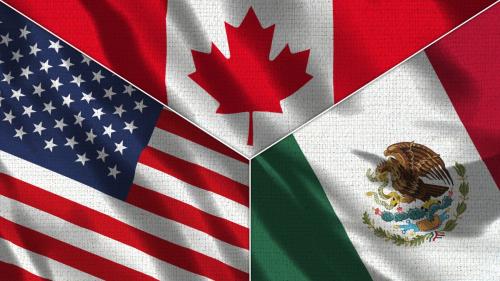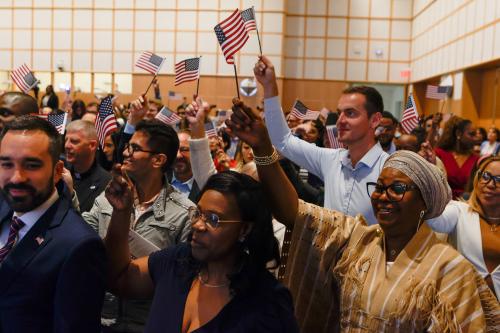This is a viewpoint from the USMCA Forward 2023 report where experts dive into the opportunities and complementary actions needed to build more integrated, resilient, and secure supply chains in North America.
 A trade agreement is much more than a text; it is a legal and institutional framework that lays the foundations for integration among the countries that sign it. It opens opportunities to prompt competitiveness, growth, and inclusive development, as well as boosts exchange dynamics beyond trade—in culture, education, and shared principles and values.
A trade agreement is much more than a text; it is a legal and institutional framework that lays the foundations for integration among the countries that sign it. It opens opportunities to prompt competitiveness, growth, and inclusive development, as well as boosts exchange dynamics beyond trade—in culture, education, and shared principles and values.
Nevertheless, without constant political dialogue, without the exchange of experiences, without a permanent updating effort, and without a tangible commitment in all the sectors that benefit from economic integration, a trade agreement runs the risk of becoming a “dead letter”: A simple list of rules to govern commercial transactions between its parties.
Nearly three years after its entry into force, the United States-Mexico- Canada Agreement (USMCA) has been instrumental in ensuring the competitiveness of the North American region’s economy in a complex and unprecedented global environment. This is no coincidence: It is the result of a joint effort among governments, the private sector, and civil society in our three countries.
During these years, the Special Committee for the USMCA Implementation in the Mexican Senate has worked in close coordination with government officials and stakeholders to take full advantage of the agreement for the benefit of Mexico and North America.
Now, it is precisely this unprecedented context that calls us to expand and deepen our integration, consolidating and creating new value chains through strategies such as nearshoring.
Global events and crises such as the COVID-19 pandemic, Russian invasion of Ukraine, trade dispute between the U. S. and China, and their effects on the global economy—while dire—have presented an opportunity that we must take advantage of.
Mexico, for instance, is a great destination for nearshoring. We have a strategic location, huge communications infrastructure network, and multiple border crossings with the U.S. that service cargo vehicles (15 according to NADBank): All factors that would make international transportation logistics more efficient in a context that demands prompt and effective solutions.
In this context, 2023 is a year full of opportunities in the USMCA implementation, in terms of opening of new markets, creation of new value chains, and innovation in strategic sectors for the future.
Recently, in the North American Leaders’ Summit, our three countries agreed to deepen economic cooperation, promote investment, and reinforce competitiveness, innovation, and resilience by:
- Organizing the first trilateral semiconductor forum with industry to adapt government policies and increasing investment in semiconductor supply chains across North America in early 2023.
- Coordinating semiconductor supply chain mapping efforts to develop a collective understanding of unmet needs.
- Expanding North American critical minerals resource mapping to collect details on resources and reserves. The Geological Surveys of each country will organize a trilateral workshop to share data and facilitate cooperation.
- Partnering with the region’s private sector to increase student development and mobility under a new North America Student Mobility Project.
- Convening industry and academia experts in semiconductors, ICT, biomanufacturing, and other key advanced manufacturing and logistics industries for design sessions on the skills needed to develop the workforce of North America over the next five years.
These announcements are great news for all of us involved in the USMCA implementation and for our countries, as they represent the possibility of consolidating a highly competitive sector, crucial for technological development in the coming decades.
Another piece of good news is the recent resolution of the panel on the differences in interpretation of the regional content rules for the automotive industry, which ruled in favor of Mexico and Canada, granting certainty to one of the most integrated sectors in our region.
But it must be said that it’s not all peaches and cream. There are some reasons for concern. Among the issues that require our special attention, the presidential decree banning transgenic corn in Mexico as of 2025 stands out; as well as the controversies over the legislation that privileges state-owned companies over their private competitors in the energy sector, which directly affected investors from our main trading partners.
On the other hand, the transition period of NAFTA’s investment protection and arbitration regime for legacy investments ends on July 1st. According to NAFTA (Article 1119), a notice of intent must be submitted at least 90 days before a claim is filed. So, the deadline to file a notice of intent and trigger the start of a NAFTA legacy investment dispute is April 1st, 2023 at the latest. Investors should be prepared for this new phase.
Finally, nothing is set in stone. As before, in 2023, seizing the opportunities and facing the challenges depends on us. From the Mexican Senate—in the Special Committee for the USMCA Implementation—we will continue working with the government, the private sector, and civil society to write new success stories in the book of our regional integration.
The Brookings Institution is committed to quality, independence, and impact.
We are supported by a diverse array of funders. In line with our values and policies, each Brookings publication represents the sole views of its author(s).










Commentary
The USMCA in 2023: Opportunities and challenges
Tuesday, February 28, 2023